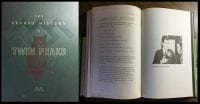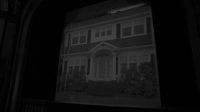The greatest challenge for a creative person is when all seems lost. In an age of content overload and virtual everything, it comes as no revelation that even functioning creators have experienced battles with ego–deflating burnouts. For some, the fitting remedy turned out to be a new visit to an old world of red rooms and cherry pies.
Twin Peaks: The Return gave diehard believers the hope of a journey back to somewhere familiar. Instead, it pushed those willing spectators into the deepest, darkest corners of their imagination. As the series began airing its groundbreaking work, something began to stir among the social media faithful. Paintings, drawings, photos, videos, and even written works appeared on various sites with an intensity that most producers and directors dream of during a project’s inception. The fury of unmemorable content a viewer would expect in the age of hashtags and followings were replaced with a plethora of projects that showed both depth and reason going far beyond the usual shades of pop culture conformity. Expanding past weekly episode aesthetics, these works of art unintentionally signaled something was growing in those willing to see it. Twin Peaks had awoken the sleeping giant of creative consciousness that had long been dormant in many of its viewers. The question remains, was it the head or the heart that actually brought them back?
The Head
For a project that dwells in the dreams and visions of certain well placed inhabitants, it’s only logical that a viewer’s mind could hold the answer. Studies show that people engage a film or series on two separate levels. While the first is a community experience that relates to the most basic cinematic elements, the second provides a closer explanation for a creative awakening. Simply put, the second level of interpretation is a personal experience that can’t be recreated between two individuals. For a project like Twin Peaks, which prides itself on community interaction as well as solo artistic endeavors, it’s the best of both worlds.
Many of these same studies suggest, different regions, socio-economic brackets, genders, and ethnicities can all make a difference in what a viewer sees. Case in point, Australian blogger Kelan Wood and his burgeoning site “An Outback Australian’s Guide to Twin Peaks“. Living in an area that Wood himself cites as a “rural” area creates an isolating effect, yet he reached the same conclusions as viewers across the world. His desire to talk about and communicate his ideas brought back hopes that he has not experienced since creative pangs in high school. While he experienced the initial viewing just as everyone else did during their first glimpse of an episode, his unique perception put into motion that hidden talent that slept for so long. Even though the blogger kept up with other Twin Peaks viewers through the internet, it still didn’t dictate how his own experience was shaped during the personal awakening. Across the world, people who didn’t interact with one another or had only limited communication report the same occurrences. Experiencing their personal insights along with the same community perceptions on the basic elements of a narrative.
The Heart
Over and over, those intrepid explorers who experienced the awakening cited feelings and emotions that stirred in them. An overwhelming sense that there was more to create in their lives, something greater than the forces that originally tore them apart from their creative pursuits. Whether they started podcasts or produced that long gestating film, something pushed them closer to reaching that long forgotten dream or that unexplored curiosity. Some could say it was purely science’s answer, but maybe it was something more. A renewal of senses driven by emotion, otherwise known as the heart.
The impact of what a person’s sees and hears influences emotion. Just like a raised heart rate during a terrifying horror film or sad demeanor after catching a devastating drama, what someone sees impacts how they feel. Creativity isn’t confined to happy moments alone, sometimes venturing into a strange fantastic place instills that needed rush. Settings in The Return offer that warm blanket of comfort from a time gone by, but it’s the newest additions to the story that push a feeling even farther. Exploring the idyllic settings of Vegas or the sparse details of Odessa offer a new perspective that jolts a settled mind expecting only what they knew 25 years earlier. It’s a shock to the system that forces gut instincts to be on high alert.
Bloggers, novelist, podcasters, filmmakers, and creatives from every medium describe a renewal that defies logic. A return to the senses that is as hard to explain as it is easy to understand in its basic structure. Sometimes, inspiring a feeling or an emotion goes well beyond the cold clinical explanation of the brain’s machinations. It’s something that speaks to the heart, especially the heart of a creative person who lost their drive. No one’s immune to the loss and gain of creativity’s whims, not even established artists. When VFX artist and filmmaker Eric Hayden first glimpsed The Return, it echoed things he had abandoned. This industry vet, with credits on some of the entertainment industry top TV series and big budget blockbusters, found himself exhausted after the release of his first film Astronaut:The Last Push. Yet with the day–to–day hassles, last minute deadlines, and family obligations, he took the time to invest himself in the adventure of digesting the The Return. What he found was the slow awakening that he didn’t realize was there until the final scene was revealed. “By the end of the show, I remembered how much I loved the original show. How much I used to love everything David Lynch had done. And I remembered how much I used to love music, and art films, and art and paintings, and all of these wonderful things that have gotten lost in being an adult.” He said of the experience. For Hayden and people like him, the connections go deeper than anything science can comprehend. It’s the dream that died, the love that was unrequited, the passion to go forward that was extinguished long ago. The powerful feeling that is hard to shake, even if someone wanted it to go back into hiding.
Is there one part of the human form or condition that is more powerful than others when it comes to renewed creativity? In the end, it may be both the head and the heart that stirred the creative revival inspired by Twin Peaks. With such a visual and auditory feast for the senses, it’s hard not to see why it was enough to turn the volume on the bravest impulses. Will the jarring effect of The Return’s style be enough to keep the sense awakened? Only the stars truly know if that time will present itself again.




